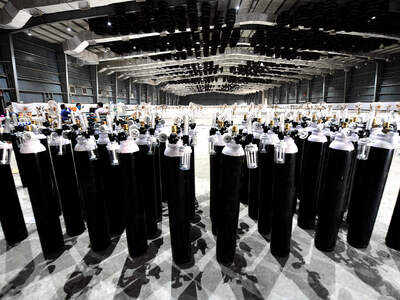- News
- City News
- patna News
- Bihar still short of tankers to procure oxygen
Bihar still short of tankers to procure oxygen

Representative image
PATNA: The state government is still unable to procure the daily quota of 274 metric tonnes of liquid oxygen fixed by the central government due to lack of sufficient cryogenic tankers. The government expects to get at least eight cryogenic tankers from the Centre to procure its complete quota of liquid oxygen.
As per the counter affidavit submitted by the health department principal secretary Pratyaya Amrit before the Patna high court, the allotment of eight additional tankers would make the state capable to lift 60MTs of liquid oxygen out of the daily quota of 274MTs.
In the affidavit submitted in high court on May 25, Amrit mentioned that the allocation of 274 MTs liquid oxygen per day appears to be sufficient for the state following drop in fresh Covid cases and positivity rate in the state.
The state government is using seven nitrogen tankers of Comfed, two liquid natural gas and three ISO-type containers of Indian Oil Corporation Limited and other containers of private gas manufacturing plants like Inox Air, Linde, Air Water India Private Limited-Jamshedpur and Gupta Air Products-Darbhanga.
Inox has been earmarked by the Centre for supplying 60MTs of liquid oxygen to Bihar and Steel Authority of India Limited 50MTs. Both the plants are located in Jharkhan’s Bokaro.
Also, 50 MTs is earmarked for allocation from Linde’s two gas manufacturing plants at Jamshedpur, 30MTs from Vedanta Electrosteel Steels Limited in Bokaro and SAIL’s another plant at Burnpur in Asansol and 20MTs from Air Water India plant in Jamshedpur. Besides, 34 MTs are being supplied by air separation units across Bihar. Some plants are functional in Patna too.
AIIMS-Patna director Dr Prabhat Kumar Singh said the oxygen crisis during the peak of second Covid wave was like a reality check for Centre and state governments. “This must be clear to everyone that oxygen production capacity in the country was not an issue. Arranging logistics and systems for its transportation was. This crisis was not envisaged early,” he said.
As per the counter affidavit submitted by the health department principal secretary Pratyaya Amrit before the Patna high court, the allotment of eight additional tankers would make the state capable to lift 60MTs of liquid oxygen out of the daily quota of 274MTs.
In the affidavit submitted in high court on May 25, Amrit mentioned that the allocation of 274 MTs liquid oxygen per day appears to be sufficient for the state following drop in fresh Covid cases and positivity rate in the state.
The state government is using seven nitrogen tankers of Comfed, two liquid natural gas and three ISO-type containers of Indian Oil Corporation Limited and other containers of private gas manufacturing plants like Inox Air, Linde, Air Water India Private Limited-Jamshedpur and Gupta Air Products-Darbhanga.
Inox has been earmarked by the Centre for supplying 60MTs of liquid oxygen to Bihar and Steel Authority of India Limited 50MTs. Both the plants are located in Jharkhan’s Bokaro.
Also, 50 MTs is earmarked for allocation from Linde’s two gas manufacturing plants at Jamshedpur, 30MTs from Vedanta Electrosteel Steels Limited in Bokaro and SAIL’s another plant at Burnpur in Asansol and 20MTs from Air Water India plant in Jamshedpur. Besides, 34 MTs are being supplied by air separation units across Bihar. Some plants are functional in Patna too.
AIIMS-Patna director Dr Prabhat Kumar Singh said the oxygen crisis during the peak of second Covid wave was like a reality check for Centre and state governments. “This must be clear to everyone that oxygen production capacity in the country was not an issue. Arranging logistics and systems for its transportation was. This crisis was not envisaged early,” he said.
FacebookTwitterLinkedinEMail
Start a Conversation
end of article
Quick Links
Delhi Air PollutionDelhi TemperatureChennai WeatherBangalore TemperatureCovid vaccination centres in DelhiCoronavirus in DelhiRTPCR test in GurgaonHyderabad RainPollution level in BangaloreDelhi SmogDelhi TemperatureNoida AQIGurgaon AQI todayFire in MumbaiMumbai RainsCovid 19 RT PCR Test in NoidaDelhi AQI todaySrinagar encounter
